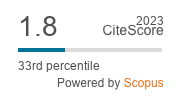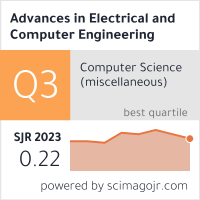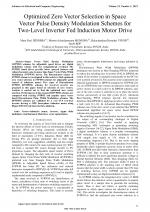| 1/2023 - 2 |
Optimized Zero Vector Selection in Space Vector Pulse Density Modulation Schemes for Two-Level Inverter Fed Induction Motor DriveJEESHMA, M. P. |
| View the paper record and citations in |
| Click to see author's profile in |
| Download PDF |
Author keywords
induction motor, inverter, sigma delta modulator, total harmonic distortion, vector quantization
References keywords
vector(17), space(15), electronics(15), modulation(12), power(11), scheme(8), multilevel(8), applications(8), motor(7), jacob(7)
Blue keywords are present in both the references section and the paper title.
About this article
Date of Publication: 2023-02-28
Volume 23, Issue 1, Year 2023, On page(s): 11 - 18
ISSN: 1582-7445, e-ISSN: 1844-7600
Digital Object Identifier: 10.4316/AECE.2023.01002
Web of Science Accession Number: 000937345700002
SCOPUS ID: 85150223686
Abstract
Space Vector Pulse Density Modulation (SVPDM) schemes for adjustable speed drives are digital modulation scheme with less computational overhead. The SVPDM based drives provide better spectral features and reduced acoustic noise in motor than Space Vector Pulse Width Modulation (SVPWM) drives. The discontinuous nature of SVPDM scheme is investigated in this article to find optimized zero vector selection in SVPDM schemes for adjustable speed control of induction motor. Five types of Discontinuous SVPDM (DSVPDM) schemes for two-level inverter are proposed in this paper based on selection of zero vectors. Analysis is carried out to find the optimized zero vector selection. Performances of the proposed DSVPDM schemes are compared with existing SVPDM and popular space vector based Discontinuous Pulse Width Modulation schemes. The DSVPDM schemes are validated for a 11.5 kVA two-level inverter driving a 3-HP three-phase induction motor using dSpace DS1104 real time interface platform. |
| References | | | Cited By «-- Click to see who has cited this paper |
| [1] C. C. Chan, "The state of the art of electric and hybrid vehicles," in Proceedings of the IEEE, vol. 90, no. 2, pp. 247-275, Feb. 2002. [CrossRef] [Web of Science Times Cited 658] [SCOPUS Times Cited 941] [2] M. Zeraoulia, M. E. H. Benbouzid and D. Diallo, "Electric motor drive selection issues for HEV propulsion systems: A comparative study," in IEEE Transactions on Vehicular Technology, vol. 55, no. 6, pp. 1756-1764, Nov. 2006. [CrossRef] [Web of Science Times Cited 370] [SCOPUS Times Cited 578] [3] K. Zhou, D. Wang, "Relationship between space-vector modulation and three-phase carrier-based PWM: A comprehensive analysis [three-phase inverters]," in IEEE Transactions on Industrial Electronics, vol. 49, no. 1, pp. 186-196, Feb. 2002. [CrossRef] [SCOPUS Times Cited 981] [4] W. Yao, H. Hu and Z. Lu, "Comparisons of space-vector modulation and carrier-based modulation of multilevel Inverter," in IEEE Transactions on Power Electronics, vol. 23, no. 1, pp. 45-51, Jan. 2008. [CrossRef] [Web of Science Times Cited 246] [SCOPUS Times Cited 334] [5] H. W. van der Broeck, H.-C. Skudelny and G. V. Stanke, "Analysis and realization of a pulsewidth modulator based on voltage space vectors," in IEEE Transactions on Industry Applications, vol. 24, no. 1, pp. 142-150, Jan.-Feb. 1988. [CrossRef] [Web of Science Times Cited 779] [SCOPUS Times Cited 1221] [6] Q. M. Attique, Y. Li and K. Wang, "A survey on space-vector pulse width modulation for multilevel inverters," in CPSS Transactions on Power Electronics and Applications, vol. 2, no. 3, pp. 226-236, Sept. 2017. [CrossRef] [7] J. T. Boys and P. G. Handley, "Harmonic analysis of space vector modulated PWM waveforms," IEEE Proceedings B (Electric Power Applications), vol. 137, no. 4, pp. 197-204, July 1990. [CrossRef] [Web of Science Times Cited 103] [SCOPUS Times Cited 143] [8] Y.-S. Lai and S. R. Bowes, "Optimal bus-clamped PWM techniques for three-phase motor drives," 30th Annual Conference of IEEE Industrial Electronics Society, 2004. IECON 2004, 2004, pp. 1475-1480 Vol. 2. [CrossRef] [9] Y. Wu, M. A. Shafi, A. M. Knight and R. A. McMahon, "Comparison of the effects of continuous and discontinuous PWM schemes on power losses of voltage-sourced inverters for induction motor drives," in IEEE Transactions on Power Electronics, vol. 26, no. 1, pp. 182-191, Jan. 2011. [CrossRef] [Web of Science Times Cited 126] [SCOPUS Times Cited 158] [10] G. Narayanan, D. Zhao, H. K. Krishnamurthy, R. Ayyanar and V. T. Ranganathan, "Space vector based hybrid PWM techniques for reduced current ripple," in IEEE Transactions on Industrial Electronics, vol. 55, no. 4, pp. 1614-1627, April 2008. [CrossRef] [Web of Science Times Cited 213] [SCOPUS Times Cited 281] [11] A. C. Binojkumar, B. Saritha and G. Narayanan, "Experimental comparison of conventional and bus-clamping PWM methods based on electrical and acoustic noise spectra of induction motor drives," in IEEE Transactions on Industry Applications, vol. 52, no. 5, pp. 4061-4073, Sept.-Oct. 2016. [CrossRef] [Web of Science Times Cited 17] [SCOPUS Times Cited 26] [12] G. Narayanan, H. K. Krishnamurthy, D. Zhao and R. Ayyanar, "Advanced bus-clamping PWM techniques based on space vector approach," in IEEE Transactions on Power Electronics, vol. 21, no. 4, pp. 974-984, July 2006. [CrossRef] [Web of Science Times Cited 136] [SCOPUS Times Cited 173] [13] T. Bhavsar and G. Narayanan, "Harmonic analysis of advanced bus-clamping PWM techniques," in IEEE Transactions on Power Electronics, vol. 24, no. 10, pp. 2347-2352, Oct. 2009. [CrossRef] [Web of Science Times Cited 58] [SCOPUS Times Cited 78] [14] O. Ojo, "The generalized discontinuous PWM scheme for three-phase voltage source inverters," in IEEE Transactions on Industrial Electronics, vol. 51, no. 6, pp. 1280-1289, Dec. 2004. [CrossRef] [Web of Science Times Cited 167] [SCOPUS Times Cited 216] [15] N. Praveena, G. Satheesh and R. Ram Prasad, "Space vector based generalized DPWM algorithms for VSI fed induction motor drive," Int. Journal of Engineering Research and Applications, vol. 3, no. 5, pp. 102-109, September 2013 [16] B. Jacob and M. R. Baiju, "Spread spectrum modulation scheme for two level inverter using vector quantized space vector based pulse density modulation" IET Electric Power Applications, vol. 5, no. 7, pp. 589-596, August 2011. [CrossRef] [Web of Science Times Cited 27] [SCOPUS Times Cited 40] [17] B. Jacob and M. R. Baiju, "Simple multilevel inverter based induction motor drive scheme using sigma delta converter with space vector quantizer" IET Journal on Power Electronics, vol. 5, no. 8, pp.1483-1490, September 2012. [CrossRef] [Web of Science Times Cited 15] [SCOPUS Times Cited 19] [18] B. Jacob and M. R. Baiju, "Vector-quantized space-vector-based spread spectrum modulation scheme for multilevel inverters using the principle of oversampling ADC," in IEEE Transactions on Industrial Electronics, vol. 60, no. 8, pp. 2969-2977, Aug. 2013. [CrossRef] [Web of Science Times Cited 25] [SCOPUS Times Cited 32] [19] B. Jacob and M. R. Baiju, "A new space vector modulation scheme for multilevel inverters which directly vector quantize the reference space vector," in IEEE Transactions on Industrial Electronics, vol. 62, no. 1, pp. 88-95, Jan. 2015. [CrossRef] [Web of Science Times Cited 56] [SCOPUS Times Cited 66] [20] J. M. Paul and B. Jacob, "Fractal based sigma delta modulation scheme for multilevel inverter," International Journal of Applied Engineering Research, vol. 13, no. 16 ,pp. 12861-12867, August 2018 [21] M. A. Menon and B. Jacob, "A simplified space vector pulse density modulation scheme without coordinate transformation and sector identification," in IEEE Transactions on Industrial Electronics, vol. 69, no. 5, pp. 4431-4439, May 2022. [CrossRef] [Web of Science Times Cited 5] [SCOPUS Times Cited 9] [22] J. M. Paul and B. Jacob, "Discontinuous space vector pulse density modulation scheme for multilevel inverter using abc coordinates," 2022 International Symposium on Power Electronics, Electrical Drives, Automation and Motion (SPEEDAM), 2022, pp. 736-741. [CrossRef] [SCOPUS Times Cited 2] [23] K. -B. Park, P. Klaus and R. M. Burkart, "Spread spectrum modulation for LCL filter design," 20th International Symposium on Power Electronics (Ee), 2019, pp. 1-6. [CrossRef] [Web of Science Times Cited 4] [SCOPUS Times Cited 8] [24] J. M. Erdman, R. J. Kerkman, D. W. Schlegel and G. L. Skibinski, "Effect of PWM inverters on AC motor bearing currents and shaft voltages," in IEEE Transactions on Industry Applications, vol. 32, no. 2, pp. 250-259, March-April 1996. [CrossRef] [Web of Science Times Cited 508] [SCOPUS Times Cited 641] [25] A. Gopinath and S. G, "A triangular 3-D coordinate system for multilevel SVPWM generation," in IEEE Transactions on Industry Applications, vol. 56, no. 4, pp. 4061-4070, July-Aug. 2020. [CrossRef] [Web of Science Times Cited 9] [SCOPUS Times Cited 8] Web of Science® Citations for all references: 3,522 TCR SCOPUS® Citations for all references: 5,955 TCR Web of Science® Average Citations per reference: 135 ACR SCOPUS® Average Citations per reference: 229 ACR TCR = Total Citations for References / ACR = Average Citations per Reference We introduced in 2010 - for the first time in scientific publishing, the term "References Weight", as a quantitative indication of the quality ... Read more Citations for references updated on 2024-07-26 02:18 in 224 seconds. Note1: Web of Science® is a registered trademark of Clarivate Analytics. Note2: SCOPUS® is a registered trademark of Elsevier B.V. Disclaimer: All queries to the respective databases were made by using the DOI record of every reference (where available). Due to technical problems beyond our control, the information is not always accurate. Please use the CrossRef link to visit the respective publisher site. |
Faculty of Electrical Engineering and Computer Science
Stefan cel Mare University of Suceava, Romania
All rights reserved: Advances in Electrical and Computer Engineering is a registered trademark of the Stefan cel Mare University of Suceava. No part of this publication may be reproduced, stored in a retrieval system, photocopied, recorded or archived, without the written permission from the Editor. When authors submit their papers for publication, they agree that the copyright for their article be transferred to the Faculty of Electrical Engineering and Computer Science, Stefan cel Mare University of Suceava, Romania, if and only if the articles are accepted for publication. The copyright covers the exclusive rights to reproduce and distribute the article, including reprints and translations.
Permission for other use: The copyright owner's consent does not extend to copying for general distribution, for promotion, for creating new works, or for resale. Specific written permission must be obtained from the Editor for such copying. Direct linking to files hosted on this website is strictly prohibited.
Disclaimer: Whilst every effort is made by the publishers and editorial board to see that no inaccurate or misleading data, opinions or statements appear in this journal, they wish to make it clear that all information and opinions formulated in the articles, as well as linguistic accuracy, are the sole responsibility of the author.





